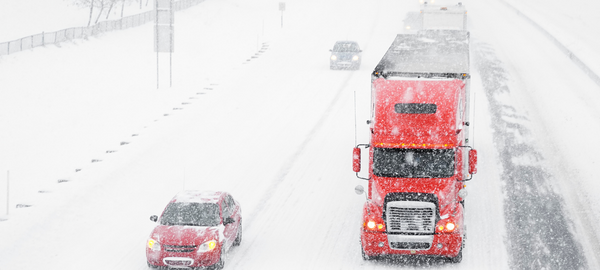Chief procurement officers face a myriad of supply chain risks from supplier insolvency to union strikes to geopolitical crises. However, an area of risk that can be overlooked is the weather. This year’s winter season has been particularly brutal across the country. Severe winter storms blanketing snow across much of the United States, including a brewing blizzard in Southern California over the weekend. The impact on supply chains is just as severe with thousands of flights canceled and roadways closed. This is not just a coincidence.
The effects of climate change can no longer be ignored. According to the NOAA’s Monthly Global Climate Report for Annual 2021, the “January-December 2021 average global surface temperature was the sixth highest since global records began in 1880.” Climate change can be attributed to a host of extreme weather events across the world. Weather can be unpredictable in the case of tsunamis, floods, and tornadoes, but even with advanced warning for events like hurricanes, the supply chain impact can be significant.
Weather Disruptions: Global Impact
How impactful is weather on the global landscape? According to Resilinc, a leading provider of comprehensive end-to-end supply chain resiliency solutions, there were more than 800 weather-related events in 2021 — an increase of 130% from the prior year, as reported by Sumit Vakil, CPO and co-founder of Resilinc, in her editorial piece for Supply & Demand Chain Executive.
Vakil commented, “Climate change is leading to the higher frequency and severity of weather disruptions. These events are wreaking havoc on supply chains,” she says. “The data shows that last year alone, disruptions due to hurricanes and typhoons affected over 123,000 supplier sites and impacted over half a million parts.”
A deeper dive can better explain why weather can be so catastrophic to global supply chains. A collaborative research project (highlighted in a Harvard Business Review article) between the University of Maryland and Resilinc assessed climate-related risks for 100 original equipment manufacturers (OEMs) and 12,000 supplier sites in the United States, China, and Taiwan. OEMs represented a variety of industries from high-tech to automobile and consumer goods.
Sites designated as highest priority were those where resilience measures (e.g., business continuity plan or alternate site) were deficient, among other factors. According to the authors, “Eighty percent of all sites in the United States and 48% of all sites in China and Taiwan have either no business continuity plans or no alternative sites lined up that could be put into operation quickly; in other words, they are unprepared for disruptions to their operations.”
Impact on CPOs
The revelation that many suppliers are not prepared for a climate/weather-related disruption should be a wake-up call for CPOs. The ripple effect of such disruptions can lead to significant operational- and revenue-related implications:
- Logistical delays moving products and servicing customers within affected areas.
- Revenue losses due to damaged product, production downtime, and lack of customer inventory.
- Supplier dilemmas involving alternate sourcing options, contractual issues (e.g., force majeure clauses), and lead time delays.
- Brand reputation ramifications originating from supply shortages, price fluctuations, and public opinion.
CPOs are facing greater pressure and responsibility for mitigating supply disruptions. Planning and preparing against a potential weather event requires a proactive approach to supply chain risk mitigation.
The Three I’s: Interconnectivity, Interdependence, and Intelligence
Weather is a constant. Thus, resiliency against weather-related events requires a holistic supply chain approach — one that involves collaboration and cooperation throughout the supply chain network. Consider the following three strategies against weather disruptions that require interconnectivity, interdependence, and intelligence to be successful.
Supply network mapping. It is essential with today’s global supply chains that CPOs map their supply networks — from a multi-tier perspective. As an enterprise, who are your first-, second-, and third-tier suppliers and where are they located? Equally important, whom do these suppliers rely on? Mapping the supplier network is an essential strategy to understand the level of interconnectivity that exists in your supply chain. It also reveals those nexus suppliers that are essential but often overlooked because of their size.
Through network mapping, CPOs can determine which suppliers are susceptible to hurricanes, typhoons, flooding, wildfires, tornadoes/cyclones, and other weather-induced destructive events. Are there critical first-tier suppliers situated in hurricane alley? Does a nexus supplier rely on a supplier where seasonal flooding is rampant? Answers to those questions are pivotal to risk mitigation strategies.
Supplier risk assessment. Mapping the supplier network is the first step. The second step is assessing the business continuity plans of suppliers. What are the supply strategies of a first-tier supplier if a facility is in the path of or affected by a weather event? Has the supplier assessed the risk of its supplier(s) and whether business continuity plans exist? Enterprises can overlook the supplier network that lies beyond the first or second tier. However, there is an interdependence among all supplier touchpoints regardless of network depth. With business continuity at the forefront of this effort, a collaborative approach with open and honest communication is required.
Weather-monitoring technologies. With the supply network mapped and supplier risk assessments completed, enterprises need the means to monitor weather activity globally. While a monumental task, there are now supply chain solutions designed specifically for this purpose using artificial intelligence and other technologies. Intelligence about potential extreme weather events and their proximity to supply partners and logistical networks is a powerful risk mitigation tool. Receive and share alerts about impending hurricanes, flooding, and other weather risks.
A look at the weather events from 2021 should be enough to convince anyone that enterprises must take climate change and extreme weather seriously. Every region of the world faces weather-induced destructive events that can bring the supply chains of multinationals to a grinding halt. Weather doesn’t spare anyone or anything. Thus, make proactive and collaborative supply chain planning a priority so you can weather the next storm.
RELATED RESEARCH
The Macro-Level Issues Impacting the CPO Right Now: Inflation
The Macro-Level Issues Impacting the CPO Right Now: Supply Assurance
The Key Themes for the Modern CPO’s Agenda (Supply Chain Risk Management)
The Key Themes for the Modern CPO’s Agenda (Risk Aversion)
The Key Themes for the Modern CPO’s Agenda (Disruption)
Procurement Agility — The Next Frontier in 2022


